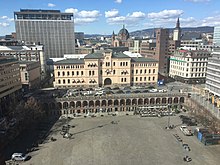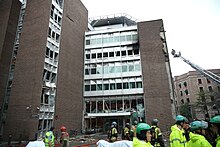Regjeringskvartalet

The Regjeringskvartalet ( German : Government Quarter ) is the area in the Norwegian capital Oslo where most of the government buildings are located. Most of the buildings extend along Akersgata , in the north of Oslo city center. In this area, the first part of the attacks in Norway in 2011 was carried out by right-wing extremist Anders Behring Breivik , which is why some of the buildings have not been used for government purposes since then. In 2014, a major renovation of the area was decided, which is to be completed by 2029.
history
First government building
In the 19th century, several hospital buildings were built in the area of today's government district. At that time the district was called Empirekvartalet. After the hospital was relocated in 1883, the area was designated as the location for the government offices, also because it is not far from the Storting National Parliament .
In 1891, the architect Stener Lenschow won the architectural competition for the proposed government building. Lenschow's plan was to build a building in the neo-renaissance style. After the architect fell ill, however, Henrik Bull took over the construction work and he changed Lenschow's plans so that an Art Nouveau building was created. The south wing was completed in 1906, but the rest of the plans were never implemented. The building was named G-blokken (German: G-Block ).
More buildings
In 1939 a new competition was called to expand the government district. However, this concern was interrupted by the Second World War and the occupation of Norway by German troops. In 1946 the jury selected a design by Erling Viksjø as the winner, but due to a dispute over its planned demolition of the former hospital building, it took until 1954 for the Storting to approve the design. The Høyblokken was completed in 1959, and the Norwegian government's conference room was on the top floor.
In 1970 the Y-blokken (German: Y-Block ) was completed, which is modeled on the UNESCO building in Paris . In 1978 the S-blokken (German: S-Block ) followed, with a facade made of red bricks. This building was used to house the Ministry of Labor and the Ministry of Health . The prison at Møllergata 19 was converted into a government building in 1981. The fourth government building was the R4 in 1988 and the R5 opened in 1996 . The R6 has also existed since 2012 .
Terrorist attack on July 22, 2011
On July 22, 2011, right-wing terrorist Anders Behring Breivik began his politically motivated assassination attempt with a car bomb in Regjeringskvartalet before carrying out another attack on the island of Utøya . The attack in the government district killed eight people and damaged the buildings. In the process, the offices of around 1,800 employees became unusable. Thus, among other things, six ministers and the state chancellery had to be relocated. The State Chancellery moved to Akershus Fortress . An investigation showed, however, that it was generally not necessary to completely demolish one of the buildings due to the damage.
Re-planning the district
The buildings that were comparatively less damaged, including the R5, were quickly put back into operation. In 2012 it was announced in the Ministry of Administration under Minister Rigmor Aasrud from the Arbeiderpartiet that a plan for the renewal of the government district would be drawn up under the leadership of the Statsbygg authority . The new Solberg government decided in 2014 that the S-blokken, the Y-blokken and the R4 should be demolished, while the Høyblokken and the G-blokken should be kept.
The demolition work for the R4 began in 2019. The planned demolition of the Y-blokken has been the most controversial as it has been a symbol of Norwegian politics since World War II. Work on the demolition finally began in March 2020. The planned start of the new building measures is in 2021, and the Storting is to give the green light in autumn 2020. The construction work is to be divided into three areas. The A and D blocks should be completed in 2025. The second section is the construction of the C-block. The third area includes the construction of the B and E-block and the renovation of the G-block. The basement areas of most government buildings are also to be connected. At Høyblokken there are plans to remove two floors and renovate the remaining floors.
building
G-blokken
The G-blokken (German: G-Block) was opened in 1906, making it the oldest government building in the district. It is therefore also called Gamle regjeringsbygning (German: Old Government Building ). Henrik Bull took over as architect. The Norwegian Ministry of Finance, the Finansdepartementet , is housed there . It was only slightly damaged during the 2011 attack and quickly reused. The property is about 2900 m², the address is Akersgata 40.
Høyblokken
The Høyblokken (German: Hoher Block ; also H-blokken ) was completed in 1959. Erling Viksjø served as the architect . The original height was 48.5 meters. The Norwegian government's conference room was on the top floor. In 1990 the building was extended by two more floors, so that a height of 56 meters was now reached. The plan for the renovation after the bombing of the Regjeringskvartalet initially provided for an additional four floors. However, after it was decided that the State Chancellery ( Statsministerens kontor ) would not move back in there, but would be housed in the newly built D-blokken, the plan was changed. Accordingly, the floors added in 1990 are to be removed.
Y-block
The Y-blokken (German: Y-Block ) was built from 1967 to 1969. The architect was Erling Viksjø. The building was named because of its Y-shaped floor plan. It was decorated with works based on sketches by Pablo Picasso that were milled into the walls. The building was erected on the vacated site of the military hospital (Militærhospitalet), which was demolished in 1962. The Y-blokken was more severely damaged by the bombing in 2011. The less damaged part of the building was used again for offices and storage after a thorough renovation.
In May 2014 it was decided to demolish the building. In the report on this decision it was noted, however, that important cultural and historical values were lost as a result, but that a better solution for the city could be found by removing the building. After several legal disputes, the demolition work began in March 2020. Valgerd Svarstad Haugland , Fylkesmann of Oslo and Viken , had previously allowed the demolition, but asked the government to reconsider its decision.
S-block
The S-blokken (German: S-Block ) was built from 1976 to 1978 after the prison at Møllergata 19 was demolished. The Ministry of Health and the Ministry of Labor were housed there until the 2011 attack . The building was demolished in 2015. The address was Einar Gerhardsens plass 3 and it was on Youngstorget .
Møllergata 19
In 1981, the building at Møllergata 19, which was built in 1866, was converted into a government building. There the organization of the ministry buildings ( Departementenes sikkerhets- og serviceorganisasjon ) was accommodated.
Grubbegata 1
The building at Grubbegata 1 was constructed from 1937 to 1940 as a court for Oslo. In 1994 the court moved to a different building and in 1998 it was finally rebuilt to include conference rooms and a canteen in the building.
R4
The Regjeringsbygg 4 (German: Government Building 4 ; R4 for short ) was built between 1985 and 1988 and had nine floors on 25,700 m². The Ministry of Oil and Energy and the Ministry of Economics and Trade were housed in the R4 . The building was badly damaged by the bombing. In May 2014 it was announced that the building would be demolished. The demolition began in April 2019 and is expected to be completed in 2020. The address was Einar Gerhardsens plass 1.
R5
The Regjeringsbygg 5 (German: Government building 5 ; R5 for short ) was built between 1994 and 1996. It is located at Teatergata 2-4. The R5 is home to the transport , municipal and modernization , oil and energy and family ministries .
R6
The Regjeringsbygg 6 (German: Government Building 6 ; R6 for short ) was built between 2009 and 2012. It is used by the Ministry of Health, as well as the Ministry of Agriculture and Food . The address is Teatergata 9.
Web links
- Regjeringskvartalet in the store norske leksikon (Norwegian)
- Regjeringskvartalet in Oslo Byleksikon (Norwegian)
Individual evidence
- ↑ a b c Ulf Grønvold: Regjeringskvartalet . In: Store norske leksikon . November 13, 2019 (Norwegian, snl.no [accessed April 10, 2020]).
- ↑ a b 00060 Regjeringskvart. Øvrige Bygg. Statsbygg, accessed April 10, 2020 (Norwegian).
- ↑ a b c d e f g Regjeringskvartalet. In: Oslo Byleksikon. Retrieved April 10, 2020 (Norwegian).
- ↑ Leif Stang, Marte Ericsson Ryste, Olav Njølstad: Bombeangrepet på regjeringskvartalet . In: Store norske leksikon . November 8, 2017 (Norwegian, snl.no [accessed April 10, 2020]).
- ^ TV 2 AS: Statsministerens kontor flyttes til Akershus festning. Retrieved April 10, 2020 (Norwegian Bokmål).
- ↑ a b Y-blokken. Statsbygg, accessed April 10, 2020 (Norwegian).
- ↑ Bygging. Statsbygg, accessed April 10, 2020 (Norwegian).
- ↑ 14902 Regjeringskvart. G-Blokk. Retrieved April 10, 2020 (Norwegian).
- ↑ a b administrasjons-og kirkedepartementet Fornyings-: Art, architecture and bygninger i regjeringskvartalet. November 12, 2018, accessed April 10, 2020 (Norwegian).
- ↑ Arve Henriksen Journalist: Høyblokken shall be tilbake til 1958-version. Retrieved April 10, 2020 (nb-NO).
- ↑ Kim Christian Priemel: Government district of Oslo: How Norway struggles for its future . In: FAZ.NET . ISSN 0174-4909 ( faz.net [accessed June 27, 2020]).
- ↑ NTB: Fylkesmannen: Y-blokka kan rives, men tenk dere om én gang til først. November 11, 2019, accessed April 13, 2020 (Norwegian).
- ↑ 00074 Regjeringskvart. - Grubbegt. 1. Statsbygg, accessed April 10, 2020 (Norwegian).
- ↑ Grubbegata 1, Oslo. Statsbygg, September 2019, accessed April 10, 2020 (Norwegian).
- ↑ Riving av R4. Retrieved April 10, 2020 (Norwegian).
- ↑ 14903 Regjeringskvart. R 5. Statsbygg, accessed April 10, 2020 (Norwegian).
- ↑ 00746 Regjeringskvart. R 6. Statsbygg, accessed April 10, 2020 (Norwegian).
- ^ Regjeringsbygg 6, R6. Statsbygg, accessed April 10, 2020 (Norwegian).


